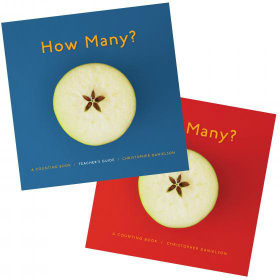How Many? Expand Kids’ Thinking about Math
How Many? A Counting Book
By Christopher Danielson
(Stenhouse, 2018 – Learn more)

How Many? A Counting Book by Christopher Danielson is a bundle (student/teacher versions) that teaches students to expand their thinking about numbers.
Before you say, “Not another counting book,” let me tell you that this book and the accompanying teacher’s guide is not your traditional counting book. The format and premise is deceptively simple, but it’s rated for grades K-12 for a reason! (If you’ve seen Danielson’s shape book you’re probably a believer.)

Likewise, we can push them to widen and deepen their perceptions – and this book is a perfect vehicle for that. When we guide our students to engage with math, we help them think creatively and become curious mathematicians.
How Many? A Counting Book is all about thinking, reasoning, wondering, and asking. It is unlike most traditional counting books that ask you to count specific items on a page. (1,2,3,4…) There is a counting task on every page of the book, but the author doesn’t specify what or how to count the objects.
The book begins with a pair of shoes. When you think of a pair of shoes, you think of the number “2”. If you take another look at the shoes on the page, you will see many ways to explore the number. Eyelets, laces, ends of shoelaces, cushions in the sole, stitching, sides of the box, holes in very worn shoes.
Turn the pages in Danielson’s student book and you will see more thought-provoking photos such as a bowl of fruit or an assortment of pizzas, along with the prompt “How many?” At first glance, you think the answer is quite easy until you realize the answers are almost endless. The photographs are vividly presented, with lots of everyday objects, including eggs, avocados, and grapefruit. (Actually, the book made me hungry!)
Learning from the teacher’s guide
As I read the teacher’s guide, I became more aware of the importance of counting and thinking. Danielson’s book is founded on current mathematical thinking and research. His work is based on experiences in the classroom and with his own children. Anecdotes about his children and students he has worked with flavor the book. He is a teacher, parent, researcher, and lover of math.
Our children need to count and organize their thinking about collections in a way that makes sense to them, and reading this fabulous book alongside a child or letting them read and ponder the pages is critical to their mathematical thinking development. As children (and adults) are reading the book, they will notice novel patterns and relationships.
The Teacher’s Bundle is an absolute bargain. Not only does it include an accompanying Teacher’s Guide, but after you purchase the bundle, you will have access to the digital format of the student version. Teachers can project the pages on a whiteboard or Smartboard and invite classroom conversations to take place.
The teacher’s guide is not a set of lessons or unit of study, but a glimpse into possible questions students might pose while exploring the book.
Taking the book to class
This book is an absolute treasure. It can be used for whole class instruction, small group, partner work, and independent work, in a classroom library, as an interactive bulletin board, or as a way to bridge the conversation about math during Back to School or Parents’ Night.
The possibilities for use of this book are endless. You can talk about patterns, quantities, shapes, spatial relationships, counting, units, grouping, place value, and vocabulary. Sit back and listen to your child or students talk math, develop questioning skills, and use descriptive mathematical language. Sit back and watch them blossom into mathematicians.
Chapter 1: Why Another Counting Book? (An honest explanation of the purpose of the book)
Chapter 2: Number learning (Research about children and how they learn about number structure and place values)
Chapter 3: How to Use How Many? In Your Classroom (Strategies to use in the classroom and how to build your own image library)
Chapter 4: Children Are Brilliant Mathematicians (Conversations from actual classrooms where this book has been used)
Chapter 5: Answers Key (Possible answers to the questions “How Many?” on each page)
Using recommended online links
As you read the student’s book and follow up with reading the teacher’s guide, you will feel a need to continue your own exploration of math conversations. Some of the resources that Danielson recommends are:
- His blog Talking Math with Your Kids (https://talkingmathwithkids.com/) which has articles and conversations centering on “How many?” (Type “How Many?” into the search box on the blog and your will be mesmerized with the conversations Danielson shares.
- The website: Number Talk Images ( http://ntimages.weebly.com/), a collection of images that can be used to begin mathematical conversations. The collection is astounding.
- Twitter: #unitchat is a collection of images and conversations from educators around the world, including photos, videos and news articles that feature numbers
How Many? A Counting Book is a book that will not sit very long on a bookshelf. If you want your students to fine tune their observation, discrimination, and visual analysis skills, this book is for you!
Now retired from teaching fourth graders, Linda Biondi is supervising preservice and student teachers at The College of New Jersey and Rider University. Last summer she co-facilitated a week-long writing institute in conjunction with the National Writing Project at Rider University. She volunteers for two service organizations: Homefront and Dress for Success of Central New Jersey – both have a mission to end poverty and homelessness. The mission of Dress for Success is to empower women to achieve through economic independence.

































